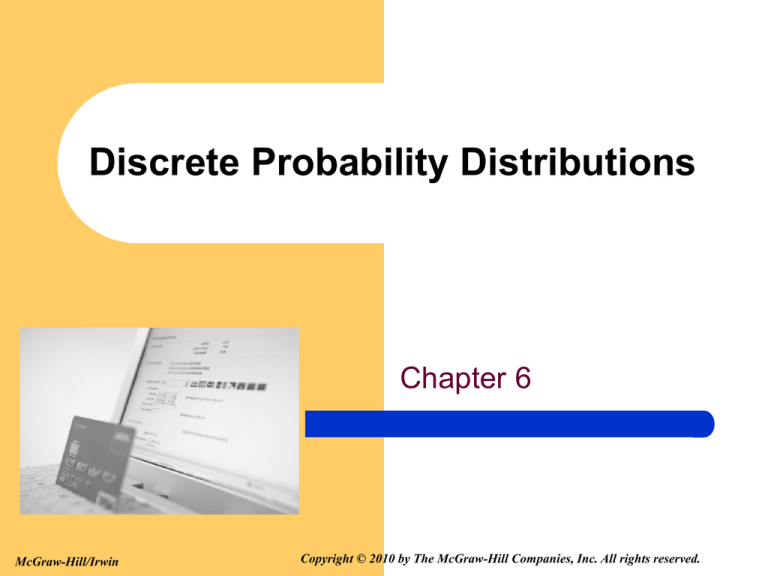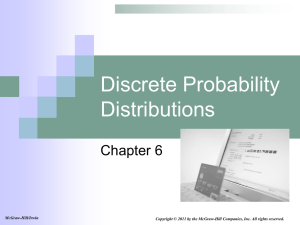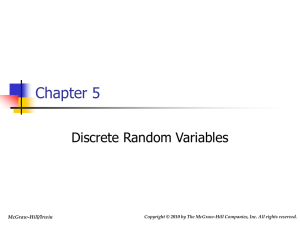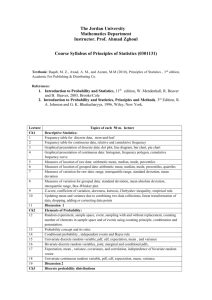
Discrete Probability Distributions
Chapter 6
McGraw-Hill/Irwin
Copyright © 2010 by The McGraw-Hill Companies, Inc. All rights reserved.
GOALS
1.
2.
3.
4.
5.
6.
6-2
Define the terms probability distribution and random
variable.
Distinguish between discrete and continuous probability
distributions.
Calculate the mean, variance, and standard deviation of a
discrete probability distribution.
Describe the characteristics of and compute probabilities
using the binomial probability distribution.
Describe the characteristics of and compute probabilities
using the hypergeometric probability distribution.
Describe the characteristics of and compute probabilities
using the Poisson probability distribution.
What is a Probability Distribution?
PROBABILITY DISTRIBUTION A listing of all the outcomes of an experiment and the probability associated
with each outcome.
CHARACTERISTICS OF A PROBABILITY DISTRIBUTION
1.
The probability of a particular outcome is between 0 and 1 inclusive.
2.
The outcomes are mutually exclusive events.
3.
The list is exhaustive. So the sum of the probabilities of the various events is equal to 1.
Experiment:
Toss a coin three times. Observe the number of
heads. The possible results are: Zero heads, One
head, Two heads, and Three heads.
What is the probability distribution for the number
of heads?
6-3
Random Variables
RANDOM VARIABLE A quantity resulting from an experiment that, by chance, can assume different values.
DISCRETE RANDOM VARIABLE A random
variable that can assume only certain clearly
separated values. It is usually the result of
counting something.
EXAMPLES
1.
The number of students in a class.
2.
The number of children in a family.
3.
The number of cars entering a carwash in a
hour.
4.
Number of home mortgages approved by
Coastal Federal Bank last week.
6-4
CONTINUOUS RANDOM VARIABLE can assume an
infinite number of values within a given range. It is
usually the result of some type of measurement
EXAMPLES
1.
The length of each song on the latest Tim McGraw
album.
2.
The weight of each student in this class.
3.
The temperature outside as you are reading this
book.
4.
The amount of money earned by each of the more
than 750 players currently on Major League Baseball
team rosters.
The Mean and Variance of a Discrete
Probability Distribution
MEAN
•The mean is a typical value used to represent the central location of a probability distribution.
•The mean of a probability distribution is also referred to as its expected value.
VARIANCE AND STANDARD DEVIATION
• Measures the amount of spread in a distribution
• The computational steps are:
1. Subtract the mean from each value, and square this difference.
2. Multiply each squared difference by its probability.
3. Sum the resulting products to arrive at the variance.
The standard deviation is found by taking the positive square root of the variance.
6-5
Mean, Variance, and Standard
Deviation of a Probability Distribution - Example
John Ragsdale sells new cars for
Pelican Ford. John usually
sells the largest number of
cars on Saturday. He has
developed the following
probability distribution for
the number of cars he
expects to sell on a
particular Saturday.
MEAN
VARIANCE
STANDARD
DEVIATION
6-6
2 1.290 1.136
Binomial Probability Distribution
1.
2.
3.
4.
A Widely occurring discrete probability distribution
Characteristics of a Binomial Probability Distribution
There are only two possible outcomes on a particular
trial of an experiment.
The outcomes are mutually exclusive,
The random variable is the result of counts.
Each trial is independent of any other trial
EXAMPLE
There are five flights daily from Pittsburgh via
US Airways into the Bradford,
Pennsylvania, Regional Airport. Suppose
the probability that any flight arrives late is
.20.
What is the probability that none of the flights
are late today?
What is the average number of late flights?
What is the variance of the number of late
flights?
6-7
Binomial Distribution - Example
EXAMPLE
Five percent of the worm gears produced by
an automatic, high-speed Carter-Bell
milling machine are defective.
Binomial – Shapes for Varying (n constant)
What is the probability that out of six gears
selected at random none will be
defective? Exactly one? Exactly two?
Exactly three? Exactly four? Exactly
five? Exactly six out of six?
Binomial – Shapes for Varying n ( constant)
6-8
Cumulative Binomial Probability
Distributions - Example
EXAMPLE
A study by the Illinois Department of
Transportation concluded that 76.2 percent of
front seat occupants used seat belts. A sample
of 12 vehicles is selected.
What is the probability the front seat occupants in
exactly 7 of the 12 vehicles are wearing seat
belts?
What is the probability the front seat occupants in
at least 7 of the 12 vehicles are wearing seat
belts?
6-9
Hypergeometric Probability Distribution
1. An outcome on each trial of an experiment is
classified into one of two mutually exclusive
categories—a success or a failure.
2. The probability of success and failure changes from
trial to trial.
3. The trials are not independent, meaning that the
outcome of one trial affects the outcome of any
other trial.
Note: Use hypergeometric distribution if experiment is
binomial, but sampling is without replacement from a
finite population where n/N is more than 0.05
Formula:
6-10
EXAMPLE
PlayTime Toys, Inc., employs 50 people in the
Assembly Department. Forty of the employees
belong to a union and ten do not. Five employees
are selected at random to form a committee to
meet with management regarding shift starting
times.
What is the probability that four of the five selected
for the committee belong to a union?
Here’s what’s given:
N = 50 (number of employees)
S = 40 (number of union employees)
x = 4 (number of union employees selected)
n = 5 (number of employees selected)
Poisson Probability Distribution
The Poisson probability distribution describes the number of times some event occurs during a specified
interval. The interval may be time, distance, area, or volume.
Assumptions of the Poisson Distribution
(1)
The probability is proportional to the length of the interval.
(2)
The intervals are independent.
Examples include:
• The number of misspelled words per page in a newspaper.
• The number of calls per hour received by Dyson Vacuum Cleaner Company.
• The number of vehicles sold per day at Hyatt Buick GMC in Durham, North Carolina.
• The number of goals scored in a college soccer game.
6-11
Poisson Probability Distribution - Example
EXAMPLE
Assume baggage is rarely lost by Northwest Airlines.
Suppose a random sample of 1,000 flights shows a
total of 300 bags were lost. Thus, the arithmetic
mean number of lost bags per flight is 0.3
(300/1,000). If the number of lost bags per flight
follows a Poisson distribution with u = 0.3, find the
probability of not losing any bags.
.
Use Appendix B.5 to find the probability that no bags will
be lost on a particular flight.
What is the probability exactly one bag will be lost on a
particular flight?
6-12
More About the Poisson Probability
Distribution
•The Poisson probability distribution is always positively skewed and the random variable has no
specific upper limit.
•The Poisson distribution for the lost bags illustration, where µ=0.3, is highly skewed.
•As µ becomes larger, the Poisson distribution becomes more symmetrical.
6-13








